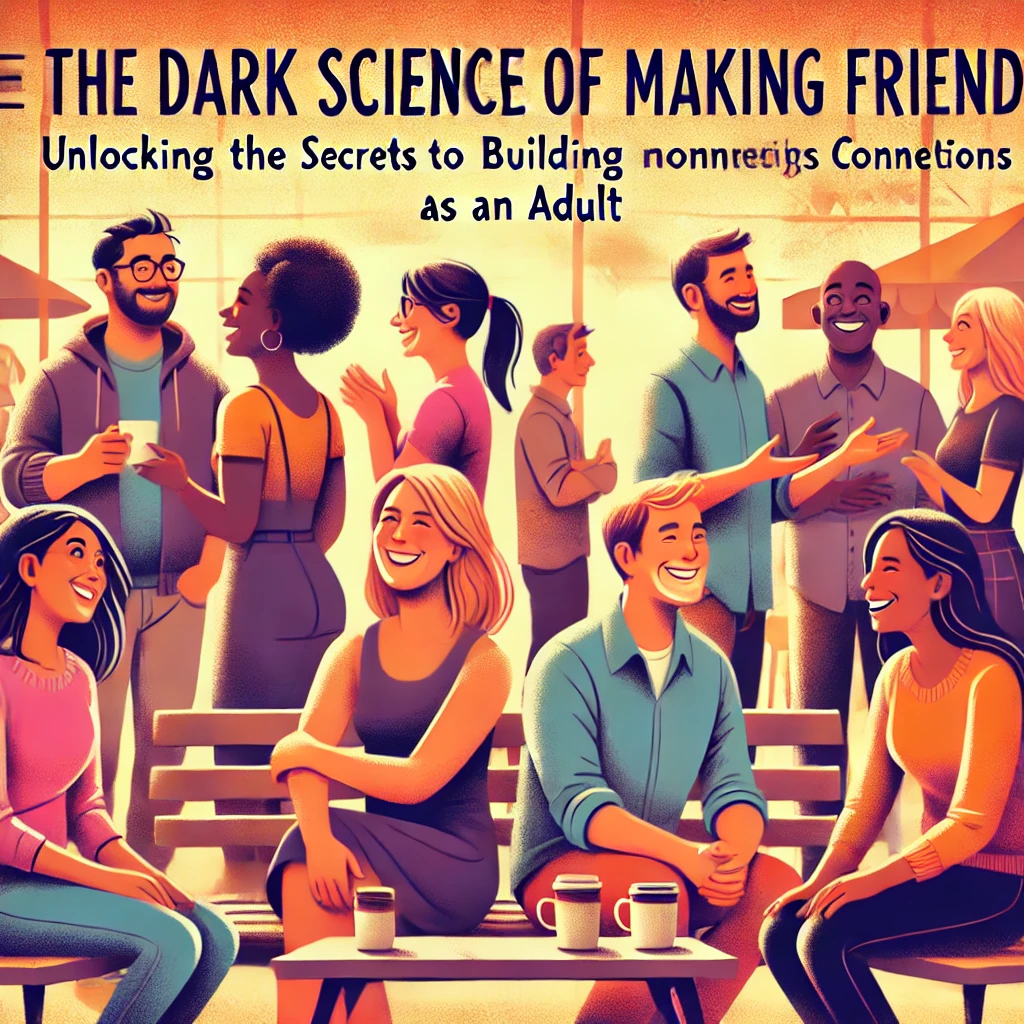Making friends as an adult can feel like stepping into a mysterious, uncharted territory. You might find yourself wondering, “Am I doing this right?” or “Why isn’t this working?” The truth is, making friends as adults is a mix of science, psychology, and a dash of strategy. Let’s dive into the “dark science” behind building friendships and help you navigate the complex art of friend-flirting, friend-wooing, and friend-matching. It’s not as daunting as it sounds—and yes, you might be doing it all wrong, but we’re here to help fix that.
1. The Science of Friend-Matching
Friend-matching is like dating but without the romantic pressure. Think about your best friend quotes—those friends who “get” you and make you feel understood. Studies suggest that shared interests, values, and even a similar sense of humor play a massive role in forming these meaningful connections. When you share core values with someone, you’re much more likely to establish a lifelong friendship.
Personal Story: A while back, I joined a community hiking group in an attempt to expand my social circle. I wasn’t necessarily looking for best friends, but one day, during a steep uphill climb, I ended up chatting with a fellow hiker about favorite movies. We discovered a shared obsession with horror films and instantly clicked. That one chat opened the door to a genuine friendship that now involves regular horror movie marathons. Sometimes, shared quirks are all it takes!
Takeaway: Seek out shared interests and get specific about your values. You’re more likely to make lifelong friendships when you meet people who resonate with the things you truly care about.
2. Are You “Friend-Flirting” Correctly?
Friend-flirting is a playful way to describe the casual, friendly gestures that signal interest in getting to know someone better. This includes everything from lighthearted teasing to positive reinforcement. The art of friend-flirting lies in building rapport and showing genuine interest in the other person without being overbearing.
Example: Think of a time when you met someone at a casual event, and you both shared a laugh about a common experience. A genuine, warm laugh can be a powerful bonding tool. In friendship science, laughing and smiling together creates a bond—people naturally feel more connected when they’re sharing a moment of joy or humor.
Takeaway: Friend-flirting is about using open body language, relaxed eye contact, and positive, light-hearted communication to make someone feel at ease. Whether it’s a laugh, a compliment, or remembering their coffee order, these little things add up to build connection.
3. Friend-Wooing – How to Show Your Interest without Overdoing It
If “friend-flirting” is the initial spark, “friend-wooing” is where you start nurturing the relationship. Friend-wooing involves planning casual hangouts or inviting them to events that fit both of your interests. The goal is to make it clear that you value spending time with them, but without overwhelming or pushing them.
Example: Remember that friend from work you casually talk to in the break room? The transition from acquaintance to friend often involves one brave step—like suggesting grabbing a coffee after work. At first, it may feel nerve-wracking. I remember doing this with a colleague, thinking, “This might seem too forward.” But that coffee led to another, then lunch, and now we’re part of a book club together.
Takeaway: Friend-wooing is about consistently showing that you’re interested in spending time with someone. But it’s essential to be respectful of boundaries and recognize that it takes time to move from acquaintances to close friends.
4. Social Success Strategies: Deciphering Friendship Body Language
Did you know that body language plays a big role in making friends? Leaning slightly forward, maintaining eye contact, and nodding while someone is talking can all signal interest and warmth. Research suggests that people are more likely to connect with you if you show open, welcoming body language.
Example: Next time you’re in a group setting, notice how people position themselves. Are they leaning in toward each other? Are they giving each other genuine smiles? These cues create a friendly, inclusive atmosphere. It’s similar to “friend-dating” where you might unconsciously mirror someone’s body language to feel closer.
Takeaway: Practice “friend body language” by showing openness, nodding to show you’re engaged, and mirroring positive body language to create a warm environment.
5. Friend-Revamp Strategy: Don’t Underestimate Casual Connections
Adult friendships are often found in the most casual connections—neighbors, gym buddies, or even parents you see at school pickups. These might seem like minor acquaintances, but they can develop into meaningful relationships.
Example: I once thought my neighbor and I were “just casual connections” until one night when I locked myself out, and she came to the rescue with a spare key. That shared vulnerability shifted the relationship, and we now have regular tea meetups. Sometimes, it’s about recognizing the potential in a relationship that seems casual at first.
Takeaway: Don’t write off casual connections! Transitioning acquaintances to friends can happen naturally over time, especially if you make an effort to show appreciation for their small gestures.
6. Friendship Maintenance – Don’t Be Afraid to Put in the Work
Once you’ve developed a friendship, it’s crucial to maintain it. This can feel like work, especially with busy schedules, but the effort is well worth it. In adult friendships, it’s essential to check in regularly, plan meet-ups, and remember special dates or important life events. Lifelong friendships aren’t born overnight; they’re nurtured with intentionality.
Example: A friend of mine has a rule to always send a quick text to her close friends at least once a month, even if it’s just a funny meme or a short “thinking of you” message. It may seem simple, but that regular touchpoint helps her keep her friends close even when life gets chaotic.
Takeaway: Put effort into keeping your friendships alive. Little actions, such as remembering birthdays, inviting friends to social events, and just checking in, go a long way in strengthening friendships.
Final Thoughts on the Dark Science of Making Friends
Mastering the science of making friends as an adult might feel tricky, but with friend-matching, friend-flirting, and friend-wooing, you can build the strong, supportive social circle you desire. Remember, friendship is a two-way street, and putting effort into casual connections can lead to lifelong friendships.
You may have been “doing it wrong” simply because making friends as an adult is hard! But with these strategies, you can revamp your friend-making approach and cultivate meaningful connections in every season of life.
10 Friendship Quotes to Inspire Connection and Lasting Bonds
Quotes about friendship can be little reminders of what truly matters in our relationships. Here are some of the best friend quotes that capture the joy, depth, and beauty of friendship:
“A friend is someone who knows all about you and still loves you.” – Elbert Hubbard
True friends accept us, flaws and all. They see our highs, lows, quirks, and everything in between, yet they stay close, supporting us along the way.
“Friendship is born at that moment when one person says to another, ‘What! You too? I thought I was the only one.’” – C.S. Lewis
This quote perfectly captures the magic of finding a friend who understands you, making the world feel a little less lonely.
“True friends are never apart, maybe in distance but never in heart.” – Unknown
Distance means little when hearts are connected. Lifelong friendships thrive even when miles apart, reminding us of the strength of true connections.
“A real friend is one who walks in when the rest of the world walks out.” – Walter Winchell
Life’s tough moments reveal who our true friends are—those who show up when everyone else walks away.
“Friendship is the only cement that will ever hold the world together.” – Woodrow Wilson
Friendships are the bonds that bring stability, support, and peace in our lives, helping us navigate the ups and downs together.
“In the sweetness of friendship let there be laughter, and sharing of pleasures.” – Khalil Gibran
Friendship is meant to be enjoyed! Sharing laughter, joy, and simple pleasures creates a beautiful, lasting bond.
“A good friend is like a four-leaf clover; hard to find and lucky to have.” – Irish Proverb
Just like a four-leaf clover, a true friend is a rare find and brings a bit of extra luck and happiness into our lives.
“Friends are the family we choose for ourselves.” – Edna Buchanan
Friendships are the relationships we create with intention. They become our chosen family, filling our lives with love, laughter, and trust.
“There is nothing on this earth more to be prized than true friendship.” – Thomas Aquinas
The gift of a true friend is priceless, a rare and cherished treasure that brings meaning and joy to our lives.
“Good friends help you to find important things when you have lost them… your smile, your hope, and your courage.” – Doe Zantamata
Friends remind us of our strengths, help us find our way, and renew our sense of hope when life gets challenging.
These quotes remind us of what friendship is truly about: acceptance, joy, resilience, and the simple pleasure of having someone who cares. Whether you’re making new friends or maintaining lifelong bonds, these words capture the essence of true connection.
Q&A: Common Questions About Making Friends as an Adult
- Q: Is it normal to feel awkward trying to make friends as an adult?
A: Absolutely! Making friends as an adult often feels awkward because we’re out of practice. Social dynamics can change over time, so it’s normal to feel unsure. Just remember, the other person may feel just as awkward, and taking small steps helps ease the process. - Q: How do I transition from casual acquaintances to actual friends?
A: Transitioning from acquaintance to friend often involves spending more time together. Start by suggesting a casual hangout, like coffee or a quick lunch, and see how things go. Regularly reaching out can also help deepen the connection naturally. - Q: What if my efforts to make friends aren’t reciprocated?
A: Don’t take it personally! People have different schedules, energy levels, and personal lives. If you feel you’re making more effort than they are, it’s okay to take a step back and focus on those who show mutual interest. - Q: Can online platforms help in making new friends as an adult?
A: Absolutely! Online platforms like Meetup, Bumble BFF, and local social groups on Facebook can be a fantastic way to meet people who share your interests. Just be open and remember to take things slow to build genuine connections. - Q: What are some good conversation starters for adult friendships?
A: Start with shared interests or something situational. Simple questions like, “How long have you been coming here?” or “What do you like to do in your free time?” are easy ways to start. As the conversation flows, try asking about hobbies or mutual interests. - Q: How do I handle rejection in friendship-building?
A: Rejection can sting, but it’s natural. Remember, it’s not a reflection on your worth but more on compatibility or timing. Keep an open mind and keep trying; it takes time to find the right connections. - Q: How do I maintain friendships with a busy schedule?
A: Consistency over frequency is key! A quick text, a spontaneous coffee date, or a shared meme can go a long way in keeping your connection strong without taking up too much time. - Q: Are there any body language tips to help make friends more easily?
A: Yes! Use open, relaxed body language like maintaining eye contact, nodding, and leaning in slightly. Smiling genuinely and mirroring the other person’s gestures subtly can also make you seem more approachable. - Q: How can I deal with the anxiety of making new friends?
A: Start by setting small, manageable goals. Instead of diving straight into deep friendships, aim to say hello, introduce yourself, or make light conversation. As you practice, your anxiety will likely decrease, and you’ll feel more at ease.



